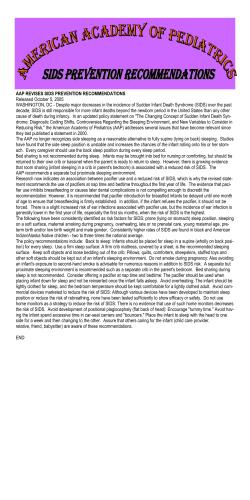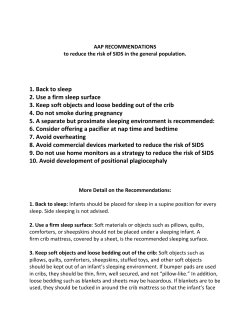
Document 15809
Sudden Infant Death Syndrome suffocation are the 3rd and 9th death for infants less than accounting for 2,971 U.S. deaths (SIDS) and infant leading causes of 1 year of age, in 2004. Between 2000-2006, 70 Miami-Dade County infants have died from either SIDS or suffocation but the incidence has declined significantly since 2003 (Figure 1). Death occurs most often during sleep, in seemingly healthy children. While that’s enough to frighten any new parent, there are particular risks for SIDS and suffocation during sleep. Avoiding those risks can reduce infant death. Figure 1. SIDS & Suffocation Deaths, 2000-2006 Miami-Dade Co. Children < 1 Year of Age 20 15 15 Deaths MIAMI-DADE COUNTY INJURY FACTS Aug 2007 Infant Deaths Due to Suffocation and SIDS Miami-Dade County, 2000-2006 10 9 10 5 SIDS Suffocation 5 3 4 6 7 4 2 0 0 2000 2001 2002 2003 2004 3 1 1 2005 2006 Risk Factors for SIDS and Suffocation Death • Co-sleeping/bed sharing (sleeping with others, including parents and siblings) • Soft, loose bedding (adult beds as opposed to cribs, sofas, pillows, blankets, etc.) • Prone sleeping (face down) • Overheating • Prematurity or low birth weight • Smoking exposure (both in-utero and after birth) Tammy was tired when she came home that night, so she fed the baby while she rested with her legs up on the sofa. When she woke several hours later, her baby’s face was against the couch cushion, her arm was over his head, and he wasn’t breathing. Infant Deaths Due to SIDS and Suffocation, 2000-2006 Page 2 of 5 Groups at Risk • Age: Infant deaths due to suffocation occurred over a wider age span than SIDS deaths (Figure 2). Sixteen percent of suffocation deaths occurred in the first month of life while another 24% occurred to infants older than 5 months of age whereas no SIDS deaths occurred during these ages. The age that a child was most at-risk for SIDS was between 1-3 months of age when three out of four SIDS deaths occurred. 74% 75% 47% 50% 26% 25% 0% 16% 0% 1 - 3 Months 3.1 - 5 Months SIDS Suffocation Figure 3. SIDS & Suffocation Deaths by Infant Gender & Race, 2000-2006 30 6 20 10 0 8 19 5 4 11 16 White Female Afr-American Afr-American Male Female Suffocation SIDS Figure 4. SIDS & Suffocation Mortality Rate by Race 3-Yr Avg Rates/1,000 Live Births, 2000-2006 5.0 Rate/1,000 Live Births • The risk of African-American infants suffering a SIDS or suffocation death has declined from being 12-times greater than white infants during the years 2002-2004 to 3-times greater between 2004-2006. > 5 Months Age Group White Male • Figure 4 compares the SIDS and suffocation mortality rates per 1,000 live births for both races averaged over rolling 3-year periods. The overall infant mortality rate has been stable for white infants since 2000 while the African-American mortality rate has seen a sharp decline since 2004. 24% 14% 0% < 1 Month Deaths • African-Americans: Deaths due to SIDS and suffocation occurred more frequently to African-American infants (49 deaths, 70%) than White infants (20 deaths, 29%). There was no significant difference in overall incidence between males and females (Figure 3). 100% Figure 2. SIDS & Suffocation Deaths by Age Group Miami-Dade Co., 2000-2006 3.9 3.8 4.0 3.0 2.8 2.7 2.0 1.0 1.3 0.4 0.4 0.3 0.4 0.3 2000-02 2001-03 2002-04 2003-05 2004-06 0.0 African-Amer. White Page 3 of 5 Infant Deaths Due to SIDS and Suffocation, 2000-2006 Risk Factors Associated with SIDS & Suffocation Deaths Figure 5. Characteristics of SIDS & Suffocation Deaths Percentages for Cases with Known Information Miami-Dade Co., 2000-2006 • A significant risk factor that was common in both SIDS and infant suffocation deaths was the infant’s sleep position. Babies were put to sleep on their stomachs or sides in 59% of the SIDS deaths and 51% of the suffocation deaths. 59% 51% Put to Sleep on Side or Stomach 18% Co-Sleeping with Adult or Child 80% 35% Slept in an Adult Bed • Four of five suffocation deaths involved infants sleeping with others (parents, siblings) and sleeping in adult beds as opposed to cribs. 80% • More than ½ of suffocation deaths involved the infant being put to sleep on a pillow. 12% Slept on a Pillow 54% 53% Recent Upper Respiratory Illness • Upper respiratory illnesses were present in the days preceding the death for more than ½ of the SIDS deaths and 36% of suffocation deaths. 36% 29% 24% Premature Birth 0% 25% 50% SIDS 75% 100% • Premature births accounted for 29% of SIDS deaths and 24% of suffocation deaths. Suffocation Infant Sleeping Situation • Seventy-two percent of suffocation deaths involved the infant co-sleeping with other persons in an adult bed. In 42% of these deaths there were two or more persons in bed with the infant. Sleeping Situation Sleeping Alone in Crib or Bassinet Suffocation deaths N (%) 11 (58%) 5 (10%) Sleeping Alone in an Adult bed 4 (21%) Sleeping with 1 Person in Adult bed 0 (0%) 15 (30%) Sleeping with 2+ Persons in Adult bed 2 (11%) 21 (42%) Sleeping with Others on Couch • SIDS deaths were more likely to be sleeping in a crib or bassinet (58%). SIDS deaths N (%) Other or Unknown Surface Total 4 (8%) 0 (0%) 4 (8%) 2 (11%) 1 (2%) 19 (100%) 50 (100%) Obstructions to the Infant’s Face Figure 6. Source of Obstruction to Nose or Mouth Suffocation Deaths 2000-2006 Mattress 30% Blood * 28% Obstructed by Person in Bed 14% Vomit 7% Pillow 7% Couch Cushion 7% * blood cannot not be differentiated as contributing to the suffocation or occurring after the death Blankets 7% A majority of suffocation deaths had evidence of an obstruction to the infant’s mouth, nose or both when they were discovered. • The most common obstruction among suffocation deaths was the infant being found face down in a mattress (30%). • 14% of the suffocation deaths involved the infant’s face being obstructed by the arms or legs of other persons sleeping with them. However, 46% of all suffocation deaths were classified as likely being the result of a ‘layover’ by another person in the same bed as the infant. • Blood was often documented as present in the infant’s nose or mouth but it couldn’t be determined if this was a contributing cause of the suffocation or had occurred after the death. Infant Deaths Due to SIDS and Suffocation, 2000-2006 Page 4 of 5 Residence of Victims Eleven zip codes of the county experienced at least 3 deaths due to SIDS or infant suffocation between 2000-2006: • Twelve deaths, 11 being suffocation cases, occurred in the adjacent zip codes of 33142, 33147 and 33150 zip codes (W. Little River, Model City, Brownsville, Allapattah, Pinewood, Little Haiti areas). • Eleven deaths (3 SIDS, 8 Suffocation) occurred in the zip codes associated with the Miami Gardens and Carol City areas (33055, 33056, 33169). • Two zip codes in the Homestead and Florida City areas of the county (33030, 33034) experienced 4 SIDS and 4 suffocation deaths. Zip Code of Residence Infant Deaths Due to Suffocation and SIDS by Zip Code of Residence 7-Year Incidence, Miami-Dade Co., 2000-2006 33030: Homestead 3 2 33055: Miami Gardens 3 2 33142: Brownsville, Allapattah, Model City 3 1 33147: W. Little River, Gladeview 4 33150: El Portal, Pinewood, L. Haiti, Model City 4 3 33157: Palmetto Bay, Cutler Bay, W. Perrine 33034: Florida City, Homestead 1 33056: Miami Gardens, Carol City 1 2 2 33161: North Miami, Biscayne Park 3 33169: Miami Gardens 3 2 33170: Goulds, Silver Palm 0 1 Suffocation SIDS 1 1 2 3 4 Number of Deaths 5 6 Page 5 of 5 Infant Deaths Due to SIDS and Suffocation, 2000-2006 Keeping Babies Safe Since 1990 the occurrence of SIDS has fallen by 50%, a benefit largely attributed to the Back To Sleep campaign, encouraging parents to put their babies to sleep in face up position. The significant fall in SIDS over this 15-year period provides hope that more can be done to reduce these deaths among our youngest and most vulnerable. Still, for those with the highest rate of SIDS, minority, and especially black infants, the reduction was not as dramatic. More is needed to reduce the risk of SIDS and suffocation, particularly in these populations. Since premature birth, low birth weight and smoking exposure are all risk factors for SIDS, the best means of SIDS prevention starts even before a baby is born. Healthy habits include: • Protecting babies from smoking exposure before and after birth • Early prenatal care • Good nutrition and health habits during pregnancy to avoid preterm delivery Once the baby is born, SIDS and suffocation deaths can be reduced by following some simple guidelines (adapted from the AAP Policy Statement, ‘Task Force on Sudden Infant Death Syndrome, 2005’) • Put the baby to sleep in a safe crib. Cribs are safer than adult beds for infants. Use a firm mattress that fully fits the crib. Remove any pillows, stuffed toys or other objects that might cover the baby’s face. Avoid blankets and loose crib bumpers. For nighttime feedings, and to be close to your baby, it’s best to place the crib close to the mother’s bed. • Don’t share your bed with the baby. Loving parents, brothers and sisters may want to snuggle up close to their baby at night, but without knowing it, they may cover the baby with an arm, other body part or pillow. Snuggle while you are wide awake, but then, put the baby to sleep in a crib. • Put the baby to sleep on its back. Though earlier recommendations also allowed for sleeping on one’s side, babies can roll over. The American Academy of Pediatrics recommends that babies be placed in their cribs on their back only, face up for sleeping. Be sure that baby sitters, grandparents and others caring for your baby do the same. • Avoid overheating. Since it is best not to put blankets in the crib, you may want to put warm pajamas on your baby when it is cool at night. That’s ok, but avoid too many layers as overheating can increase risk to your baby. • Consider a pacifier for sleep. Some studies have found that pacifiers reduce the risk of SIDS if used at nap and bedtime. However, it is cautioned that their use should be delayed until one month of age in breast fed infants, should never be forced on a baby or re-inserted after the baby has fallen to sleep, and should not be coated with juice or sugar Produced by the Miami-Dade County Injury Surveillance System Data Sources: Death Certificates & Miami-Dade Medical Examiner Dept. PHONE (IFCK): 305-804-7212 (MDCHD): 305-470-5649 E-MAIL: [email protected] http://dadehealth.org/injury/INJURYintro.asp
© Copyright 2024












